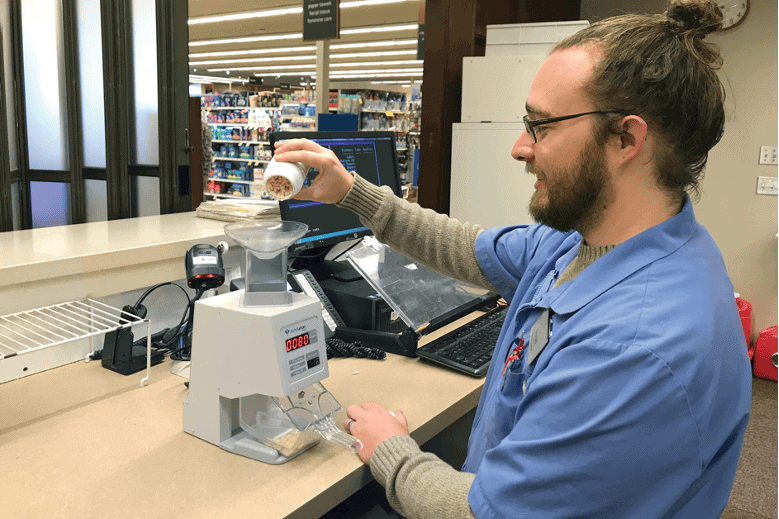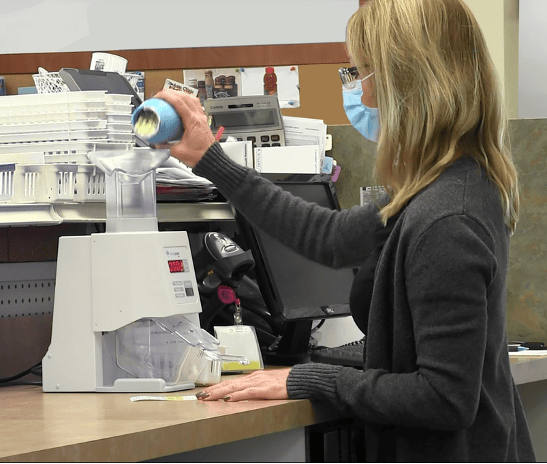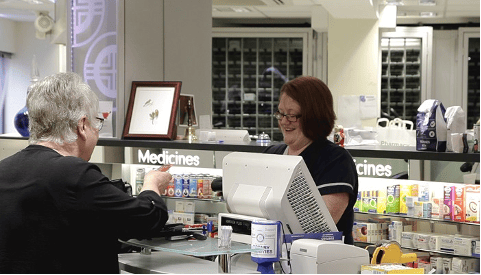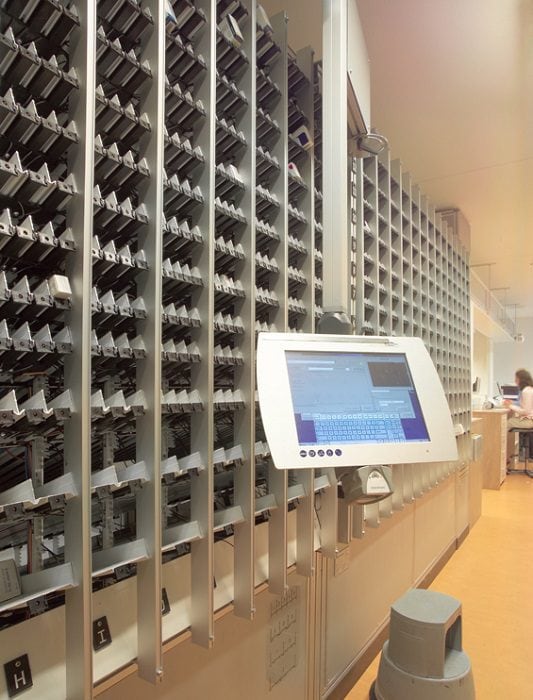
When it comes to pharmacies managing patient medication, patient safety and high-quality care have always been paramount. However, the unfortunate truth is that human errors can sometimes occur, potentially leading to dire consequences. Recognizing this critical challenge, the concept of pharmacy automation has emerged and evolved over several decades.
But what exactly is pharmacy automation? It is the process of using technology to improve how you securely store, dispense, manage, and reorder medications and report all related activity to simplify the entire medication management process. Today’s advanced automation systems far surpass their predecessors, offering a remarkable combination of accuracy and seamless integration into day-to-day operations, ultimately leading to enhanced inventory management, money- and labor-savings, and better pharmacy-patient interaction and counsel.
What Are the Benefits of Pharmacy Automation Solutions?
Automation software operates on a set of rules: when X occurs, Y automatically happens. The role of automation is to make a repetitive process work on its own so that you reduce or minimize human input and free up time and resources.
Early automation systems were designed for large health systems and filling centers, taking up a substantial amount of square feet. However, a new generation of technology is affordable, compact, and now more accessible for community or specialty pharmacies. The right system helps improve security, optimizes inventory, reduces errors, and speeds up dispensing processes.
Improves Accuracy to Ensure Medication Is Correct
Medication errors have historically caused severe problems for pharmacists and pharmacy owners. In the United States alone, 7,000 to 9,000 people die annually because of a prescribing or dispensing error. Thousands of additional patients also experience medication complications or other side effects but don’t report these problems.

Pharmacy automation technology can help improve medication accuracy and reduce these risks. A counting device, for example, can safeguard against prescription filling errors. A simple counter can handle counting to eliminate quantity errors and enable the staff to perform inventory checks more frequently. For example, the Kirby Lester KL1 counts almost any tablet or capsule quickly, conveniently, and accurately. It is ideal for narcotics management and physical inventory counting and superior to manual counting.
Devices with scan-verification software, such as the Kirby Lester KL1Plus, take counting a huge step further. This small device forces a medication check on each count, matching medication dispensed to the medication prescribed and checking strength, quantity, and dose. Plus, it can force a double count of controlled substances.
Speeds Up Processes for Pharmacy Staff and Patients
No matter how experienced a pharmacist or tech you are, a machine will almost always be faster. A pharmacy workflow automation can take over repetitive, lower-acuity tasks and streamline your operations, helping you fill prescriptions with higher levels of speed and confidence.
Robotic pharmacy dispensing machines, for example, can automate well above 50% of a community pharmacy’s daily prescriptions and dispense, label, count, and present medications within a few seconds of ordering. A scan-verification process also runs checks and balances, alerting you to drug mismatches and recording every fill in seconds. If discrepancies occur, you can quickly review your records and verify how the prescription was filled and where the error occurred.
These quality assurance and compliance management processes are time-consuming when completed by hand. However, automation can accelerate them while also providing accurate and detailed records and prescription fills. Consequently, you free up your pharmacy technicians to focus on patient interactions, improving patient care and reducing patient wait times.
Optimizes Inventory Management and Reduces Overstocking

A pharmacy’s success is tightly tied to its inventory. Without medications on hand, you can’t fill prescriptions or help patients, which leads to a loss of revenue and confidence. However, managing your prescription volumes is also a delicate balance. You must ensure you have enough available so that patients don’t have to wait for shipments but not so much that you have a high expiration loss, overcrowded shelves, and an abundance of “slow movers.” All of which negatively affect the pharmacy’s available cash flow.
Automation systems are a viable solution for inventory management and compliance. Counting devices, software packages, and automatic dispensers track output quantities and automatically update inventory, reducing stock redundancies and unnecessary reordering. Electronic logs also replace manual records and sync with your pharmacy software, helping you run smoother reconciliations and maintain tighter control of narcotics and other sensitive or expensive drugs.
Frees Up Floor and Storage Space
Most pharmacies allow for substantial space to house medications and supplies. Automated medication storage and retrieval systems with dispensing robots can free up floor and storage space.

Depending on the technology, these storage systems hold, track, and dispense anywhere from 50 to 90% of your pharmacy stock. For example, RoboPharma’s high-density robotic dispensing units and software can hold nearly all of a pharmacy’s medications in one place and deliver pre-packaged medications in seconds. RoboPharma robotics are ideal for environments filling a majority of medications in unit-dose or blister packs.
With limited space, you create a compact yet secure channel storage system and add channels as needed. Store thousands of doses in multiple formats and track quantities in each dispenser, maximizing your space and inventory. These solutions work well in busy hospital pharmacies, community pharmacies, or central filling facilities that handle mostly blister cards or pre-packaged drugs.
Automated dispensing carts are also a multi-purpose option for clinics and hospitals. With these carts, you can condense medications into a mobile location, allowing for safe storage and dispensing at the point of care. You can manage inventory at a fraction of the cost and space by switching to automated medication storage.
Reduces Labor Costs & Builds Business
A common suspicion around adopting automation solutions is a loss of jobs, but prescription automation frequently does not necessitate cutting or replacing staff. Instead, when thoughtful pre-planning happens before implementation, automation systems refocus or redistribute your pharmacy technicians from low-value to high-value tasks.
Your operations become more efficient as you offload repetitive work to technology, and your staff has more time to focus on patients or business-building initiatives (like medication synchronization, star ratings, vaccinations, and over-the-counter product consultative sales. Automation software is especially useful during peak times of the day or week or when you’re short-staffed.
The devices can also pick up some of the routine work and allow staff to focus on more complex tasks that require more effort or strategic expertise. All these tasks must be completed within the pharmacy, but automation helps you execute them without spending extra on overtime pay or hiring more employees.
When pharmacists and technicians can take on more patient care and profit-generating work like consultations, patient education, or immunizations, the staff is more productive, lowering your operation costs and improving your revenue and profit margins.
Improves Patient Care Through Better Engagement

Automated technologies allow pharmacies to shift time and resources from administrative work to patient care. With less time spent on redundant tasks, pharmacy staff have more time to engage with patients, answer questions, and educate patients on health and wellness.
Innovative technologies such as automated prescription kiosks also allow you to offer precision care around the clock. Place filled prescriptions in a secure carousel, and patients can retrieve their medications when it’s convenient.
You not only improve patient care with a faster, streamlined pick-up experience, but you also improve time savings for both you and your patient.
The Best Automation Technology to Optimize Your Pharmacy
Before you choose a system, consider a few points. First, what is the most common medication packing in your region? Do you typically dispense pre-packs, units of use, bulk tablets, or capsules in vials? The type of automation hardware and software will differ according to your needs.
Then, examine where your employees spend the most time and where they are the most inefficient. Are employees bumping into each other? Are they backtracking throughout the day? Are their physical actions enabling mistakes? Are higher-wage employees doing tasks that lower-salary employees could handle?
Then select automation products for rapid deployment, like those from Capsa Healthcare, or build a custom system to meet your needs. Capsa Healthcare has worked in the pharmacy automation and health IT industries for over 60 years. Our pharmacy automation consultants and designers understand the risks of medication errors and how to improve workflows. For new-generation software and better performance, choose innovative solutions from Capsa Healthcare. Learn more about how our pharmacy automation technology can help you today.